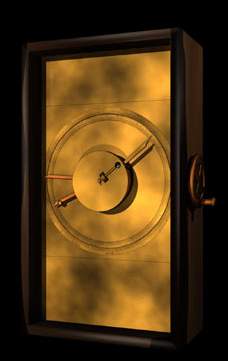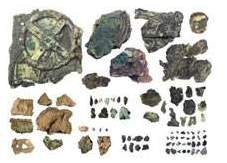|
  
- 积分
- 29170
- 威望
- 1262
- 金钱
- 0
- 阅读权限
- 110
- 在线时间
- 5112 小时
|
2#
 发表于 2006-11-30 11:08
发表于 2006-11-30 11:08
| 只看该作者

查了点相关的英文资料
The Antikythera mechanism
The clockwork computerSep 19th 2002
From The Economist print edition
An ancient piece of clockwork shows the deep roots of modern technology

WHEN a Greek sponge diver called Elias Stadiatos discovered the wreck of a cargo ship off the tiny island of Antikythera in 1900, it was the statues lying on the seabed that made the greatest impression on him. He returned to the surface, removed his helmet, and gabbled that he had found a heap of dead, naked women. The ship's cargo of luxury goods also included jewellery, pottery, fine furniture, wine and bronzes dating back to the first century BC. But the most important finds proved to be a few green, corroded lumps—the last remnants of an elaborate mechanical device.
The Antikythera mechanism, as it is now known, was originally housed in a wooden box about the size of a shoebox, with dials on the outside and a complex assembly of bronze gear wheels within. X-ray photographs of the fragments, in which around 30 separate gears can be distinguished, led the late Derek Price, a science historian at Yale University, to conclude that the device was an astronomical computer capable of predicting the positions of the sun and moon in the zodiac on any given date. A new analysis, though, suggests that the device was cleverer than Price thought, and reinforces the evidence for his theory of an ancient Greek tradition of complex mechanical technology.
Michael Wright, the curator of mechanical engineering at the Science Museum in London, has based his new analysis on detailed X-rays of the mechanism using a technique called linear tomography. This involves moving an X-ray source, the film and the object being investigated relative to one another, so that only features in a particular plane come into focus. Analysis of the resulting images, carried out in conjunction with Allan Bromley, a computer scientist at Sydney University, found the exact position of each gear, and suggested that Price was wrong in several respects.
In some cases, says Mr Wright, Price seems to have “massaged” the number of teeth on particular gears (most of which are, admittedly, incomplete) in order to arrive at significant astronomical ratios. Price's account also, he says, displays internal contradictions, selective use of evidence and unwarranted speculation. In particular, it postulates an elaborate reversal mechanism to get some gears to turn in the right direction.
Since so little of the mechanism survives, some guesswork is unavoidable. But Mr Wright noticed a fixed boss at the centre of the mechanism's main wheel. To his instrument-maker's eye, this was suggestive of a fixed central gear around which other moving gears could rotate. This does away with the need for Price's reversal mechanism and leads to the idea that the device was specifically designed to model a particular form of “epicyclic” motion.
The Greeks believed in an earth-centric universe and accounted for celestial bodies' motions using elaborate models based on epicycles, in which each body describes a circle (the epicycle) around a point that itself moves in a circle around the earth. Mr Wright found evidence that the Antikythera mechanism would have been able to reproduce the motions of the sun and moon accurately, using an epicyclic model devised by Hipparchus, and of the planets Mercury and Venus, using an epicyclic model derived by Apollonius of Perga. (These models, which predate the mechanism, were subsequently incorporated into the work of Claudius Ptolemy in the second century AD.)
A device that just modelled the motions of the sun, moon, Mercury and Venus does not make much sense. But if an upper layer of mechanism had been built, and lost, these extra gears could have modelled the motions of the three other planets known at the time—Mars, Jupiter and Saturn. In other words, the device may have been able to predict the positions of the known celestial bodies for any given date with a respectable degree of accuracy, using bronze pointers on a circular dial with the constellations of the zodiac running round its edge.
Mr Wright devised a putative model in which the mechanisms for each celestial body stack up like layers in a sandwich, and started building it in his workshop. The completed reconstruction, details of which appeared in an article in the Horological Journal in May, went on display this week at Technopolis, a museum in Athens. By winding a knob on the side, celestial bodies can be made to advance and retreat so that their positions on any chosen date can be determined. Mr Wright says his device could have been built using ancient tools because the ancient Greeks had saws whose teeth were cut using v-shaped files—a task that is similar to the cutting of teeth on a gear wheel. He has even made several examples by hand.
How closely this reconstruction matches up to the original will never be known. The purpose of two dials on the back of the device is still unclear, although one may indicate the year. Nor is the device's purpose obvious: it may have been an astrological computer, used to speed up the casting of horoscopes, though it might just as easily have been a luxury plaything. But Mr Wright is convinced that his epicyclic interpretation is correct, and that the original device modelled the entire known solar system.
The Greeks had a word for itThat tallies with ancient sources that refer to such devices. Cicero, writing in the first century BC, mentions an instrument “recently constructed by our friend Poseidonius, which at each revolution reproduces the same motions of the sun, the moon and the five planets.” Archimedes is also said to have made a small planetarium, and two such devices were said to have been rescued from Syracuse when it fell in 212BC. This reconstruction suggests such references can now be taken literally.
It also provides strong support for Price's theory. He believed that the mechanism was strongly suggestive of an ancient Greek tradition of complex mechanical technology which, transmitted via the Arab world, formed the basis of European clockmaking techniques. This fits with another, smaller device that was acquired in 1983 by the Science Museum, which models the motions of the sun and moon. Dating from the sixth century AD, it provides a previously missing link between the Antikythera mechanism and later Islamic calendar computers, such as the 13th century example at the Museum of the History of Science in Oxford. That device, in turn, uses techniques described in a manuscript written by al-Biruni, an Arab astronomer, around 1000AD.
The origins of much modern technology, from railway engines to robots, can be traced back to the elaborate mechanical toys, or automata, that flourished in the 18th century. Those toys, in turn, grew out of the craft of clockmaking. And that craft, like so many other aspects of the modern world, seems to have roots that can be traced right back to ancient Greece.
http://www.economist.com/displaystory.cfm?story_id=1337165 |
|









 发表于 2006-11-30 11:07
|
发表于 2006-11-30 11:07
| 





 。
。



 拜托你先看懂原文再理解
拜托你先看懂原文再理解